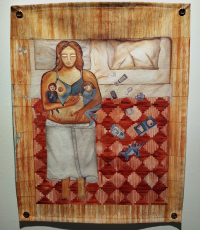
The sky is grey and heavy, and it is quiet as the light rain that has been falling pauses as I walk into CoCA Toi Moroki. The weighted softness of the weather carries me down the hall to a similarly grounded space. Without seeking any other information just yet I see the exhibition title, Kia ora Whaea, and a gallery full of ngā māmā.
A squared union jack stitched together from sheets and nappies waves me into the critical conversation of Māori motherhood in relation to colonisation in Caitlin Rose Donnelly’s Ōritetanga. The cloth has been washed in paint, reminding me of the domestic labour of laundry and cleaning up after bubs that have disproportionately been conducted by women, and the red, of bleeding through cloth sometimes. Neighbouring this, Kate Stevens West’s Moe places the sheets in context. A breastfeeding whaea lying with two pēpi in her arms in bed, eyes closed, is surrounded by pain relief, cream, baby wipes, her phone, a toy, pukapuka, sippy cup, nappy, and hairbrush. The waistband of her pants rolled down shows her puku with stretch marks and a c-section scar, raising awareness of maternal hauora. West’s Taoka 1-24 brings Mātauranga Māori to the fore in depictions of everyday items and their equivalent Indigenous technology, pairing a pack of Panadol with a sprig of Horopito and a sewing machine with the elegant bends of bone needles. These three artworks swiftly establish the focus of the show with the grit and grace the subject matter requires.
Moving slowly through this space a lyrical melody seems to seep through the walls. Upon leaving the show I hear a sung tihei mauri… fading in and out above me. I investigate and it seems fitting that the Canterbury Museum’s exhibition Ngā Hau Ngākau (Breath of Mine) that links the songs of ngā manu with taonga puoro, hovers above Kia ora Whaea. Lending their breath and waiata to the mothers below (like they do their children), these birds circulate the spirit of the show. This breath allows for the pain, difficulty, and danger of motherhood, exacerbated by colonisation, to sit alongside the love, respect, and gratitude for ngā whāea. This sentence should read as follows. (It's just replacing the "is" with "are" for the plural.)
"As I leave the gallery the pause in the rain and its lightness are over, and I am graced by hearty droplets on my head. I enjoy the timing of the downpour and reflect that the timing of Kia ora Whaea feels equally well observed."
DETAILS
Caitlin Rose Donnelly, Piupiu Maya Turei, Alix Ashworth, Vicki Marie Lenihan, Kate Stevens West, Emma Kitso, Kia ora Whaea
CoCA Toi Moroki
10 Feb-17 Mar
IMAGE: Kate Stevens West, Moe, 2022, Gesso, coloured pencil and oil paint on canvas, 530mm x 680mm—courtesy of the artist and CoCA Toi Moroki, photo by Owen Spargo
